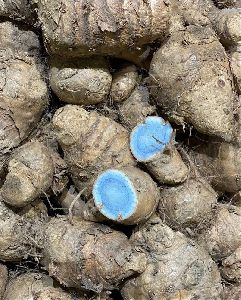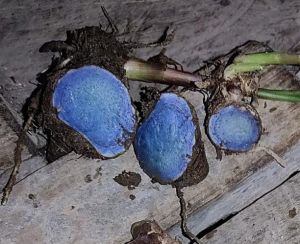
Black Turmeric
100 - 200 Per Kilogram
50 Kilogram (MOQ)

Black Turmeric
300 - 400 Per Kilogram
Best Deals from Black Turmeric

Black Turmeric
Get Price Quote
10 Kilogram (MOQ)

Black Turmeric Finger
200 - 300 Per Kilogram
5 Kilogram (MOQ)

Black Turmeric
550 Per Kilogram
500 Kilogram (MOQ)

GVEI Black Turmeric Flakes
3,000 Per Kilogram
100 Kilogram (MOQ)
Black turmeric is a rare and potent variety of turmeric, known for its distinctive dark blue to black rhizomes. The raw form of black turmeric flakes is made from the dried, carefully sliced rhizomes of this unique plant. Unlike the more commonly used yellow turmeric (Curcuma longa), black turmeric has a slightly different flavor profile, with earthy, spicy notes and a mildly pungent aroma. In herbal teas: Add a few black turmeric flakes to hot water or tea blends for a soothing, anti-inflammatory drink. In cooking: Use the flakes in curries, soups, or stews to infuse your dishes with the earthy, spicy flavor of black turmeric. For pastes or powders: Grind the flakes into a powder to create your own turmeric paste for topical applications or culinary use.

Black Turmeric
50 - 70 Per Kilogram
500 Kilogram (MOQ)

Black Turmeric
Get Price Quote
100 Kilogram (MOQ)

Black Turmeric
5,000 - 5,500 Per
2 Ton (MOQ)
Pure Organic, Based on request we will prepare this product and deliver it

Black Turmeric
Get Price Quote
10 Ton (MOQ)

Black Turmeric Finger
Get Price Quote
1 Ton (MOQ)
Black Turmeric, also known as Black Zeda, or Curcuma caesia, is a rare and exotic variety of turmeric native to India and Southeast Asia. Its unique dark color and earthy flavor set it apart from regular turmeric. Characteristics - Deep blue-black color - Earthy, slightly sweet flavor - High in curcuminoids (curcumin, demethoxycurcumin) - Rich in antioxidants, anti-inflammatory compounds - Anti-bacterial, anti-fungal properties Origin - India Culinary Uses - Traditional Indian and Southeast Asian recipes - Adds depth to curries, stews, and soups - Enhances flavor in meat, seafood dishes - Used in Ayurvedic and Unani medicine Health Benefits - Anti-inflammatory, antioxidant properties - Relieves joint pain, arthritis - Supports digestive health - May help reduce cancer risk Skincare Benefits - Anti-inflammatory compounds soothe skin irritations - Antioxidants combat aging, wrinkles - Natural antiseptic, antibacterial properties Packaging - Available in whole, powdered forms Shelf Life - 12-18 months from packaging date Storage - Store in cool, dry place - Protect from direct sunlight, moisture

Pure Black Turmeric Finger
300 - 350 Per Kilogram
20 Quintal (MOQ)

Black Turmeric Finger
130 - 400 Per Kilogram
1 Container (MOQ)
Black turmeric, also known as Curcuma caesia, is a rare variety of turmeric native to Northeast India and other parts of Southeast Asia. Unlike the more common yellow turmeric (Curcuma longa), black turmeric has a dark bluish-black rhizome and is valued for its potential medicinal properties. Here are some details about black turmeric: Appearance: The rhizomes of black turmeric are dark bluish-black on the outside and deep blue on the inside, giving them a distinct appearance compared to the bright yellow-orange rhizomes of yellow turmeric. Medicinal Uses: Black turmeric has been traditionally used in Ayurvedic and folk medicine for various purposes. It is believed to have anti-inflammatory, antioxidant, and antimicrobial properties. It has been used to treat various ailments, including respiratory disorders, skin diseases, digestive issues, and arthritis. Bioactive Compounds:Like yellow turmeric, black turmeric contains bioactive compounds such as curcuminoids, volatile oils, and other phytochemicals. However, the composition of these compounds may differ between black and yellow turmeric, leading to potentially unique health benefits. Culinary Uses: While black turmeric is primarily valued for its medicinal properties, it is occasionally used in culinary applications, particularly in certain regional cuisines of Northeast India. However, its culinary use is less common compared to yellow turmeric. Cultivation: Black turmeric is a tropical plant that thrives in warm, humid climates. It is typically grown as a perennial herb and requires well-drained soil and ample sunlight. However, cultivating black turmeric can be challenging due to its specific environmental requirements and relatively low yield compared to yellow turmeric. Availability: Black turmeric is considered a rare and exotic herb, and its availability may be limited compared to yellow turmeric. It is often cultivated on a small scale by local farmers in the regions where it is native. Commercial Products: Black turmeric is used to produce various commercial products, including herbal supplements, powders, extracts, oils, and skincare products. These products are often marketed for their potential health and wellness benefits. When purchasing black turmeric products or raw rhizomes, it's essential to ensure they are sourced from reputable suppliers who adhere to quality standards and ethical harvesting practices. Additionally, consult with a healthcare professional before using black turmeric or any herbal supplement, especially if you have underlying health conditions or are taking medications.

Black Turmeric
150 - 250 Per Kilogram
1 Kilogram (MOQ)

Black Turmeric Finger
3,000 - 4,000 Per Kilogram
500 Kilogram (MOQ)

Fresh Black Turmeric
450 - 2,200 Per kilogram
25 Kilogram (MOQ)
Black turmeric in the form of Fingers and bulbs, GCMS chemical profiling attached in the photos.

Black Turmeric
200 - 300 Per kilogram
1 Ton (MOQ)

Black Turmeric Finger
Get Price Quote
1 Ton (MOQ)

Raw Black Turmeric
1,000 Per Kilogram
50 Kilogram (MOQ)

Black Turmeric
300 - 350 Per Kilogram
300 Kilogram (MOQ)
Black turmeric, also known as Curcuma Caesia or Black Zedoary, is found in parts of North East India and Madhya Pradesh. The plant grows in a similar manner to yellow turmeric, with pale yellow flowers which have a reddish border. It is a rare herb which is available in both powdered and fresh forms.14-Jan-2021